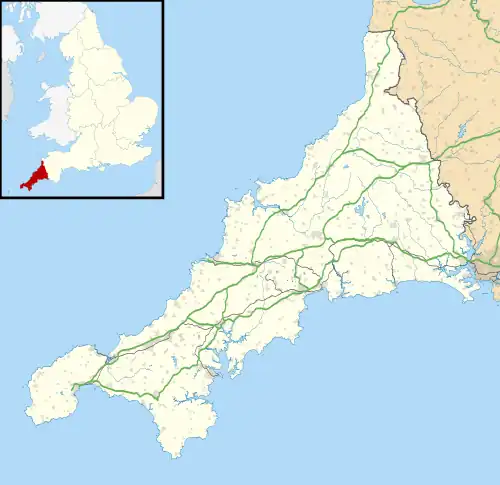Stoke Climsland
Stoke Climsland is a village in the valley of the River Tamar, Cornwall, England, United Kingdom within the civil parish of Stokeclimsland. The population of the parish including Luckett at the 2011 census was 1,703.[1] An electoral ward of the same name also exists. At the same census the population was 3,703.[2]
| Stoke Climsland | |
|---|---|
 Main Road, Stoke Climsland | |
 Stoke Climsland Location within Cornwall | |
| OS grid reference | SX360744 |
| Civil parish |
|
| Shire county | |
| Region | |
| Country | England |
| Sovereign state | United Kingdom |
| Post town | CALLINGTON |
| Postcode district | PL17 |
| Dialling code | 01579 |
| Police | Devon and Cornwall |
| Fire | Cornwall |
| Ambulance | South Western |

History
The manor of Climsland was one of the seventeen Antiqua maneria of the Duchy of Cornwall. The manor was recorded in the Domesday Book (1086) as Climson; there were 5 hides of land and land for 24 ploughs. One hide was held by the lord (with 3 ploughs and 9 serfs) and 30 villeins and 30 smallholders had 17 ploughs and 4 hides of land. There were also 3 acres of meadow, 16 square leagues of pasture and 3 square leagues of woodland. The income from the manor was £6 sterling.[3]
In the 12th century, Climsland became part of a 250 hectares (620 acres) royal deer park called Kerrybullock, or Carrybullock, until it was disparked by Henry VIII in the 16th century.[4] The park was mentioned in 1282 and its extent was 600 acres. In 1337 the park was recorded as being three leagues around and as having 150 deer. In 1352 Edward the Black Prince sent 6 of the oaks to Stoke for the building of the church there and in 1357 ordered that herds of deer be sent to his other parks at Launceston and Trematon to restock them. In the park was a lodge, still called Lodge House in 1677. Along with other ducal parks Carrybullock was disparked c. 1540 by King Henry VIII; for the next four and a half centuries it became pasture for cattle (today's Duchy Farm).[5]
Notable buildings
The present church building is 15th century, with north and south aisles and a west tower. The tower is of granite and the wagon roofs are medieval. At Horse Bridge on the road to Tavistock is a fine bridge of seven arches (built in 1437). At Whiteford Sir John Call built a Georgian mansion in 1775 but it no longer exists: the stables and a garden temple remain and a few fragments have been reused in a house nearby.[6]
The post office, opened in 1839, is the oldest sub-Post Office in the UK.[7]
Horse Bridge is a listed medieval bridge across the River Tamar opposite Horsebridge in the parish of Sydenham Damerel in Devon.
Sport
The village had a football team called Stoke Climsland who were champions of Duchy League 2 2017/18 Cornwall Duchy league. , however the team has no disbanded.
Cornish wrestling
Cornish wrestling tournaments, for prizes, were held in Stoke Climsland in the 1800s.[8]
Notable people
- William Pratt Call, banker and High Sheriff of Cornwall; resident of Whiteford House
- John Grubb, an early settler in Delaware
- Len Harvey, a boxer, who held one 'version' of the World's Light-Heavyweight Championship from 1939 until 1942; born here
- Charlotte Mary Matheson, novelist; herdsman
- David Oates, archaeologist and academic; born here
- Neil Warnock, football manager; resident
References
- "Parish population 2011". Retrieved 14 February 2015.
- "Ward population 2011". Retrieved 14 February 2015.
- Thorn, C., et al., eds. (1979) Cornwall. Chichester: Phillimore; entry 1,9
- North Cornwall District Council, "Luckett: Conservation Area Character Statement" (PDF), Cornwall.gov.uk, p. 3
- Henderson, Charles (1935) Essays in Cornish History; ed. by A. L. Rowse and M. I. Henderson. London: Oxford University Press; Cornish deer parks; pp. 160-161
- Pevsner, N. (1970) Cornwall, 2nd ed. Penguin Books
- "BBC - Domesday Reloaded: Stoke climsland Post Office, from 1986". domesday. Retrieved 19 January 2015.
- The Western Morning News, 20 June 2014.